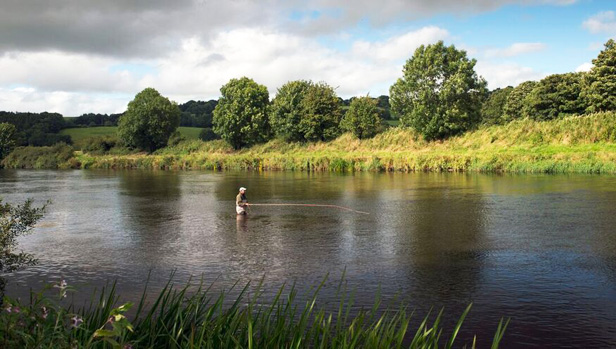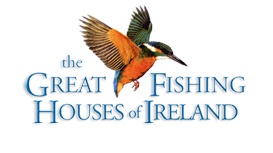

The Rivers
River Liffey
Season:
Salmon and Sea trout: 1 January to 30 September
Brown Trout: 1 March to 30 September
The Liffey rises only 12 miles south of Dublin and flows in a huge crescent for over 82 miles before entering the sea at Dublin Bay. Along its course, it drains a catchment of nearly 530 square miles. This is a big river and a very interesting river with a great diversity of character. It starts as a poor acid mountain river and is transformed into an extraordinarily rich trout stream as it glides and meanders through the plains of Co Kildare. It flows over a range of differing geologies – from granite, to sandstone, to sandstone-limestone and finally to pure limestone. Dr Michael Kennedy, formerly of the Inland Fisheries Trust, observed some of the fastest-growing brown trout ever recorded in Ireland in the river near Lucan.
It goes without saying that a river which flows through a capital city the size of Dublin cannot avoid the undesirable effects and demands of such a thickly populated and heavily industrialized area. It has been dammed at Pollaphuca to form one of the largest reservoirs in Europe and there is a second reservoir at Leixlip (Leixlip means Salmon Leap, from the Norse lax, salmon). Water abstraction is a huge problem. There are three hydro-electric power stations along its course. Consequently, the flow is controlled artificially and the river is subject to artificial spates which bear no relation or have no connection whatsoever with natural rainfall.
The lower stretches from the city out to beyond Leixlip tend to be slow and deep with a series of old mill weirs. Out in the country beyond Celbridge, the river takes on a more natural character. Access to the river downstream of Leixlip can be difficult in places and the banks are undeveloped. Upstream of Straffan to Ballymore Eustace, a lot of good work has been done by the Eastern Regional Fisheries Board which organized a social employment scheme and there has been a lot of bank clearance and stiles and footbridges have been constructed.
Most of the fishing is controlled by clubs or private interests. There is free fishing at the Memorial Park at Islandbridge and on the left bank immediately above Leixlip Bridge to the River Rye confluence. The later can provide useful summer grilse fishing and the access to it is via the car park of the Ryevale Hotel.
Salmon
The salmon run has improved dramatically in recent times and the numbers recorded on the fish counter at Islandbridge have increased from a low of less than 220 fish in the early 1970s to over 4,000 in 1989. Spring salmon can be taken from early Januray and grilse run from June, with July providing the peak of the run. It is very difficult to quantify catches but it is estimated that well over 100 spring fish were taken in 1990. Most Liffey salmon are taken either by spinning or on worms. Most of the spring fish are taken at Islandbridge, while the grilse tend to run through and most are taken on the fisheries up to Leixlip and the rest upstream of the Leixlip dam in late August and September – water permitting. It takes a natural flood rather than an artificial spate to get the salmon to run up river and, of course, they cannot pass the dam at Golden Falls above Ballymore Eustace.
Sea-trout
The river gets a small run of sea-trout. The best of the fishing is in July on the Dublin and District Salmon and Trout Anglers’ Association water immediately above and below the bridge at Islandbridge. Fly fishing at night is said to be most productive. Useful flies are Peter Ross, Butcher, Bloody Butcher and Teal, Blue and Silver.
Brown Trout
The Liffey brown trout are not terribly big but they are there in good numbers and the water is extremely clean. Trout are found from Islandbridge upstream but the best of the trout fishing is above Leixlip and all the way to Ballymore Eustace. The average weight at Clane is 9 – 11 oz and one in six would weigh 1 lb. A 3 lb trout would be considered an exception. It is thought that the average size is declining on the river. It is noticeable that the weight of the trout increases the further downstream you fish.
The Liffey has all the usual fly hatches associated with a rich river. There are plenty of dark olives in spring but the iron blue hatch is patchy and mayflies are scarse. The best fishing of the season is in May and after that September can be very good. There are excellent hatches of sedges including grey flags. You don’t have to be too particular with your sedge pattern – the trout will usually take any small brown sedge pattern. The river has a heavy hatch of yellow evening duns around Clane. The trout take the hatching insects freely but are incredibly difficult to catch on summer evenings. The blue-winged olive is present and the trout take it spasmodically. It is important to note that the Liffey blue-winged olive has a very dark wing and if you are to imitate it successfully you must dress a very dark blue dun hackle on the Orange Quill.
Excerpts taken from "Trout & Salmon Rivers of Ireland, an angler's guide" by Peter O'Reilly.

